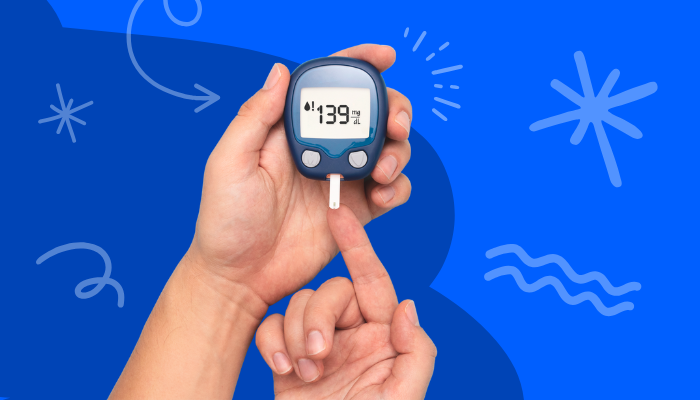Table of Contents
Key Takeaways
- Home diabetes tests like glucose meters and A1C kits can be a convenient way to track blood sugar levels without constant clinic visits.
- The accuracy of these tests depends on how you use them, whether they’re expired, and how you store the strips or sensors.
- Lab tests are still the gold standard, but home testing can help track daily trends and long-term goals.
If we’re being honest, nobody wants to run to a clinic every time they need to check their blood sugar. These days, home diabetes tests let you check glucose and keep tabs on overall health without leaving your living room.
If you’re at risk for diabetes or already living with it, home testing is a practical way to notice changes. Most devices give quick results, and they’re surprisingly accurate when you use them right. Still, home testing should complement regular check-ins with your healthcare provider. A professional can help interpret test results and guide you on the best treatment plan.
What Is A Home Diabetes Test?
A home diabetes test is a way to check your blood sugar without making a trip to the doctor’s office. It can be convenient for keeping an eye on things, whether you’re trying to prevent diabetes or already managing it.
These are the main types of home diabetes tests:
- Blood glucose meters: These are the go-to for quick answers, with many people using them multiple times a day. You prick your finger, place a drop of blood on a strip, and get a reading in seconds. Examples include the Contour Next ONE, the True Metrix Go, and the TRUENESS meter.
TRUE METRIX GO® Glucose Meter Starter Kit with USB Data Cable

$ 45.30
$ 56.63
The small TRUE METRIX GO® blood glucose meter is twisted onto a vial of TRUE METRIX Test Strips, while enhanced performance features make this the ideal meter for users seeking everyday testing convenience. Enhanced performance features, such as 7-, 14-,… read more
- Continuous glucose monitors (CGMs): These use a small sensor under the skin to track glucose around the clock. They send updates every few minutes to your phone or a reader, which may be useful for those who need to watch their numbers closely. Examples include the Dexcom G7 and the Freestyle Libre 3 Plus.
FreeStyle Libre 3 Plus Sensor

$ 129.77
$ 162.21
FreeStyle Libre 3 Plus iCGM Sensor Kit Features: ACCURATE. The most accurate iCGM system to help reduce time spent in hypoglycemia*3 and improve overall glucose control*3,4. Extended sensor for up to 15 days. DISCREET. The world’s smallest?2, thinnestII, _ smaller than… read more
- At-home A1C kits: These measure your average blood sugar over the past 3 months. They’re good for finding long-term trends you might miss with daily checks. They’re not for everyday monitoring but can help track overall diabetes control. Examples include the A1CNow Self Check and the TRUEplus A1CNow Self Check Test System.
TRUEplus A1CNow Self Check Test System - 2 Count Test Kit

$ 39.99
$ 57.99
TRUE+A1CNowTM Self Check Test System Features: Results in 5 minutes Small (5 µL) fingerstick blood sample No maintenance Room temperature storage Small, compact, and battery powered Affordable and easy to use Includes A1CNowTM Self Check Analyzer 2 Cartridge Pouches 2… read more
These products can vary in what specific features they have. For example, some glucose meters save past readings and connect to smartphone apps for easier tracking. Certain CGMs have longer-lasting sensors or faster warm-up times than others. In addition, some A1C kits let you get results instantly at home instead of mailing them in.
The best home diabetes test often comes down to your budget, how often you need to test, and whether you prefer basic readings or more detailed tracking tools.
Type | How It Works | Common Use |
Blood glucose meters | Quick finger-prick for an instant reading | Daily checks before or after meals |
CGMs | Tiny sensor under the skin tracks glucose all day | Ongoing monitoring throughout the day |
A1C test kits | Finger-prick sample that can be mailed in to a lab or offers results in minutes | Long-term or quarterly tracking |
Who Are They For?
Home diabetes tests are mainly for people living with diabetes who want to keep an eye on their blood sugar or A1c between visits. There’s no need to schedule a bunch of appointments just to see where you stand.
However, they’re also great for people at higher risk. Maybe you’ve got a family history, you’re carrying extra weight, or your lifestyle puts you in the high-risk zone. Regular testing can catch those early blood sugar spikes.
If you’re feeling off and wondering about diabetes, these tests can help you figure out what’s going on. Some symptoms to watch for include:
- Increased thirst
- Peeing all the time
- Weight loss you can’t explain
- Feeling fatigued
- Blurry vision
In addition, here are some blood sugar and A1c levels you may want to keep in mind:
- Fasting Blood Sugar
- Normal: Below 100 mg/dL
- Prediabetes: 100–125 mg/dL
- Diabetes: 126 mg/dL or higher (confirmed with repeat testing)
- A1C (Average Blood Sugar Over 3 Months)
- Normal: Below 5.7%
- Prediabetes: 5.7%–6.4%
- Diabetes: 6.5% or higher (confirmed with repeat testing)
- Random Blood Sugar (Any Time of Day)
- Diabetes: 200 mg/dL or higher, along with symptoms like frequent urination or excessive thirst
Just remember to always consult a healthcare provider to confirm your results before making any changes to your treatment or lifestyle. Home tests are a useful tool, but they can’t replace a professional diagnosis or medical advice.
How Accurate Are Home Diabetes Tests?
While home diabetes tests can be convenient for checking blood sugar levels, the accuracy can vary depending on the test and how you use it.
Different factors that can affect the accuracy of the test include:
- Expiration date: Old test strips or kits can give false readings. Always check the date before using them.
- How they’re stored: Strips and sensors don’t like heat, moisture, or freezing. Storing them in the wrong place could mess with your results.
- Keeping it calibrated: Some older meters need to be calibrated regularly by comparing them to a control solution or lab reading. However, many meters, such as the NovaMax, are already auto-calibrated.
- How you use it: Not washing your hands, using too little blood, or not following the directions can throw off the numbers.
- When you test: Your blood sugar changes during the day. Testing at random times can make it harder to compare your results.
While home tests are convenient, they should be seen as a guide rather than the final word on your health. If your readings seem unusual or you’re noticing symptoms, it’s important to follow up with a healthcare provider.
Lab Testing Vs. Home Testing
Both lab and home tests check your blood sugar, but they’re not the same. Still, each one has its place in diabetes care.
Unlike home tests, lab testing is done in a medical facility that has special equipment and quality control processes. Therefore, it’s often more accurate than most home devices. In addition, many labs can look at additional health markers that a home device might not be available for.
In any case, a lot of people use both: daily home checks to see patterns, then lab tests every so often to double-check accuracy and get more information. It’s not unusual for home test results to be a bit off from lab numbers. Maybe it’s the meter, the test strips, or just how you did the test. However, labs are less likely to have those hiccups.
Tips For Getting The Most Accurate Results At Home
If you want to get the most of your glucose meter or other home test, there are some ways to ensure accuracy. Follow some of these tips to get the best results from home diabetes tests:
- Wash and dry your hands before you test. Even a little food or lotion can mess with your reading. If your hands are cold, washing them in warm water can help to get the blood flowing.
- Use the right test strips for your meter. Don’t mix brands, and keep your strips somewhere cool and dry. Always check the expiration date since expired strips can throw things off.
- Try to test at the same time every day. Most people pick before meals and at bedtime. It can be easier to see patterns if you have a routine.
- Follow the instructions for your meter. That means how you put in the strip, how much blood you use, and how you read the result. It’s easy to skip a step, but that can affect accuracy.
If a reading seems too high or low compared to what you usually see, you can test again. Use a new strip and a different finger if you have to. Some meters, like the Contour Next test strips, let you add more blood if you didn’t get enough the first time.
It’s also not a bad idea to bring your meter to your next doctor’s appointment. You can compare your home reading with the clinic’s to see how close they match up.
Bottom Line
Home diabetes tests let you check your blood sugar or A1C levels without making a trip to the clinic. You’ll find a few different types out there, mainly fingerstick glucose meters, CGMs, and even A1c kits. However, these tests aren’t always accurate and consistent, so you’ll still want to have regular lab tests and doctor visits to make sure everything lines up. For people with diabetes or prediabetes, home diabetes tests can be a convenient solution.
Picking the right test comes down to your health goals and your budget. You can start by browsing the available products on Total Diabetes Supply.
FAQs
What Is A Home Diabetes Test?
A home diabetes test is a way to check your blood sugar without making a trip to the doctor’s office. It can be convenient for keeping an eye on things, whether you’re trying to prevent diabetes or already managing it.
Who Are Home Diabetes Tests For?
Home diabetes tests are mainly for people living with diabetes who want to keep an eye on their blood sugar or A1c between visits. They're also great for people at higher risk, such as a family history of diabetes, or those at risk due to lifestyle.
Are Home Diabetes Tests Accurate?
What Is The Difference Between Home Diabetes Tests and Lab Tests?
Unlike home tests, lab testing is done in a medical facility that has special equipment and quality control processes. Therefore, it’s often more accurate than most home devices. In addition, many labs can look at additional health markers that a home device might not be available for.
Sources
- Risk Factors for Type 2 Diabetes, National Institute of Diabetes and Digestive and Kidney Diseases (2022)
- Warning Signs and Symptoms, American Diabetes Association (n.d.)
- What Is the A1C Test?, American Diabetes Association (n.d.)
- Blood Glucose Monitoring, StatPearls (2023)
- The Impact of Not Washing Hands on the Result of Capillary Glycemia, Journal of Clinical and Molecular Endocrinology (2016)
- Home blood sugar testing, Mount Sinai (n.d.)







